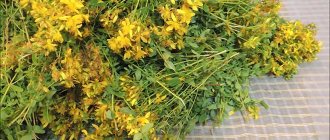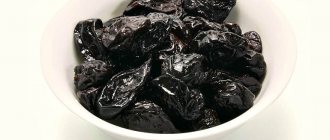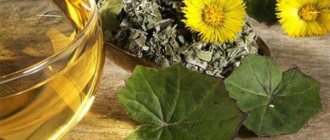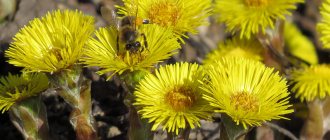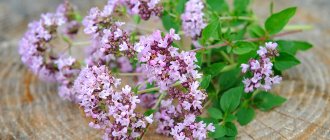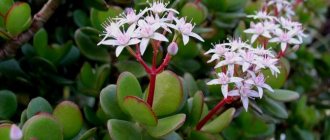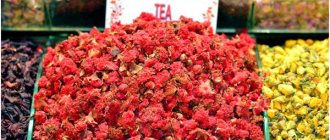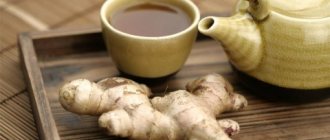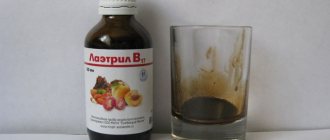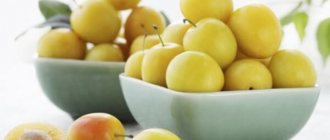Coltsfoot (in the description of the composition of dosage forms you can find the Latin name Tussilago) belongs to a monotypic genus of herbaceous perennial plants from the Asteraceae family.
It blooms with yellow flowers located on low flowering shoots, even before the wide leaves bloom, smooth on one surface and rough on the other. Flowering season is early spring (April).
Flowers and leaves have medicinal properties. A concentrated extract is obtained from plant raw materials, and is also used in dried and fresh form.
It grows in Eurasia, Eastern Siberia, North Africa and North America, in the mountainous areas of Central Asia and Southern Siberia. Favorite places are areas free of turf, near water bodies, in meadows, clearings, and along roads.
Chemical composition of the plant
The active chemical composition determines the medicinal properties of coltsfoot:
Leaves:
| Flowers:
|
Coltsfoot: medicinal properties for coughs
1. To prepare the infusion, pour a large pinch of dry raw material into an enamel bowl and add a glass of drinking water. Close the container and cook for 15 minutes, stirring, in a water bath. The infusion is allowed to stand for 45 minutes, then filtered.
Add drinking water to the resulting drink until the amount of the drink reaches 200 ml. The infusion can be stored for no more than 2 days if placed in a cool room. The drink should be drunk warm. You need to drink 75-100 ml. 3 times daily 1 hour before meals.
2. To prepare another remedy, a large pinch of dry herb is steamed with boiling water, 200 ml is enough. The composition must be placed on the stove for 10 minutes of boiling. Then leave for a quarter of an hour and filter. You need to take a large spoon three times a day.
3. Smoking raw crushed leaves of the plant will help reduce spasmodic cough. The raw materials are wrapped in tissue paper and smoked like a cigarette. Inhaling smoke from smoldering fresh leaves will also help. Smoking also helps with toothache.
I recommend reading:
Sophora japonica: use, medicinal properties and contraindications
Healing properties of mother and stepmother
- Anti-inflammatory effect
- Expectorant and sputum thinning action
- Diaphoretic effect, helping to reduce body temperature
- Antispasmodic effect - relieves spasm of smooth muscles of internal organs
- Enveloping and regenerating effect
- Hypotensive effect
- Lipid-lowering effect
- Antiseptic and antibacterial action.
Indications for use
Raw materials and herbs of coltsfoot, the properties of which have long been studied, are used as auxiliary therapeutic agents in the treatment of the following groups of diseases:
- Inflammatory diseases of the respiratory system: bronchitis, pharyngitis, sore throat, pneumonia, pulmonary tuberculosis, asthma.
- Acute respiratory diseases of a viral nature, including influenza.
- Diseases of the gallbladder, liver and biliary tract, pathologies of the gastrointestinal tract, urinary system, stomatitis.
- Cardiovascular diseases: coronary artery disease, stage 1-2 hypertension, atherosclerosis, inflammation of the superficial veins of the lower extremities.
- Diseases of the skin and its derivatives: burns, boils, purulent wounds, inflammatory rash, erysipelas, diathesis, scrofula, alopecia (hair loss).
Coltsfoot in home cosmetology
The coltsfoot herb, its decoctions and infusions are added to masks with a rejuvenating and lifting effect, to enrich creams, tonics, lotions, and hair products.
For facial skin
Coltsfoot preparations gradually but deeply cleanse pores, eliminate inflammation of small blood vessels, and treat acne. An alcoholic tincture of the herb has the property of whitening age spots and lightening freckles.
Cosmetic ice:
To 50 ml of decoction add 2-3 drops of rosewood essential oil and 10 ml of linseed oil. Enhances the beneficial properties by adding 10 ml of fresh coltsfoot juice. The ingredients are mixed and frozen in special forms.
Massage with ice cubes in the morning quickly relieves swelling and puffiness. Regular use restores the oval of the face, rejuvenates and refreshes the skin. But cryotherapy, instead of benefit, can cause harm in case of rosacea, enlarging spider veins.
Anti-wrinkle mask with seaweed: 50 ml of warm decoction of coltsfoot will require 30 g of crushed kelp. Preparation:
- Algae powder is mixed with liquid and left for 15 minutes to completely swell.
- Add 10 g of oil to the mixture and mix.
- The finished mass is distributed on the face and left for 30–40 minutes.
The mask has the ability to improve microcirculation in blood vessels, restore cells, enhance nutrition and oxygen saturation of the skin.
For hair beauty
An infusion of coltsfoot with nettle will help with severe dandruff and hair loss. Herbs taken 2 tbsp. l. each, pour a liter of boiling water, leave for half an hour, filter. Rinse hair after each wash.
Treatment with coltsfoot drugs
Tea
For one tsp. dry flowers, take 250 ml of boiling water, pour over the raw materials and cover with a lid, let it brew for 10 minutes. Helps with cough, and also promotes the thinning of sputum and its excretion. Take 100 ml twice a day.
Infusion
- Helps restore the body during illness;
- Reduces high blood pressure;
- Reduces cholesterol formation;
- Helps relieve muscle spasm of internal organs during cholecystitis, gastritis;
- Used as a mild expectorant;
- Helps with sweating of the feet, armpits, face;
- Effective for inflammation of the veins, wounds, boils, ulcers, herpes zoster;
- Helps cure inflammation in the throat and intestines.
1 tbsp. dry, pre-crushed leaves, brew 250 ml of boiling water, leave for about 40 minutes, strain. Inside: take three tablespoons. before meals four times a day. Externally wipe the affected areas or make compresses with infusion. Gargles are effective in treating the throat, and enemas with infusion are used to treat the intestines.
Decoction
1 tbsp. dry raw materials (leaves) pour 250-300 ml of boiling water and simmer over low heat for about 10 minutes, cover with a lid and leave for half an hour. Helps with diseases of the respiratory system and ENT pathology, scrofula, and general weakness. Drink one tbsp. before meals three times a day.
Strong decoction
2 tbsp. dry coltsfoot and stinging nettle raw materials are poured with boiling water (300 ml), boiled for about 10 minutes over low heat, filtered and cooled. Effective for oily scalp and hair loss. Rinse your hair with the resulting decoction after washing.
Applications
A fresh leaf of the plant is ground to a pasty state and applied on sterile gauze to a problem area (calluses, erysipelas, inflammatory lesions on the skin, inflamed veins).
Inhalations
1 tbsp. Brew a mixture of dry leaves and flowers with boiling water in a volume of 200 ml, cover with a towel and breathe over the infusion. Accelerates recovery from bronchopulmonary pathology. Do not inhale at elevated body temperatures.
Fresh Juice
Effective in the treatment of infectious rhinitis. The juice is squeezed out of the fresh leaves of the plant and one or two drops are instilled into each nasal passage 3 times a day. The juice is also used to treat acne by lubricating the affected skin 3 times a day.
Syrup
- Recipe 1. Freshly squeezed plant juice is mixed with powdered sugar in a 2:1 ratio. Store in the refrigerator. Helps in the treatment of pulmonary tuberculosis and pneumonia. Take 1 tbsp. five times a day before meals.
- Recipe 2. Fresh leaves are placed in a 1 cm layer on the bottom of a thick-walled metal enamel dish, and a 1 cm layer of sugar is poured on top. The layers are repeated until the dish is completely filled. Close with a tight lid and leave for 3 weeks in the cellar or refrigerator. The leaves and sugar should become a homogeneous green mass, which is mixed with honey (2:1 ratio). Used for the treatment of tuberculosis cavities: 1 tbsp. three times a day before meals.
Foot baths
Brew two handfuls of dry coltsfoot raw materials with boiling water in a volume of 2 liters, leave for 5 minutes and take a bath for 20 minutes without straining the raw materials. Contributes to the treatment of ARVI.
Alcohol infusion
The coltsfoot broth is diluted with vodka in a ratio of 4:1. Wipe the skin with the infusion 3-5 times a day. Indicated for the treatment of pustular skin lesions, boils, acne (see how to get rid of acne).
Powder
Dry leaves of the plant are ground into powder, which is used:
- for oral administration, 1 g three times a day, washed down with hot milk. Helps in the treatment of diseases of the gastrointestinal tract and respiratory system;
- externally: sprinkle on inflamed areas 2-3 times a day. Effective in getting rid of diathesis, sweating of the feet, erysipelas, furunculosis.
Leaves compress
Fresh leaves of the plant are poured with hot cream and the raw material is allowed to soften.
- Helps prevent mastitis at its first signs (applied warmly to the mammary gland).
- Reduces the severity of cough (warm leaves are placed on the chest and covered with a towel).
Mother and stepmother in folk medicine: recipes
Flowers and leaves are used in decoctions as an expectorant, diaphoretic for colds, as well as for gastritis, inflammation of the mucous membranes, kidney diseases, cystitis, colitis and enteritis. A decoction of nettle half with coltsfoot helps against dandruff, hair loss and itchy scalp.
To prepare a decoction of the leaves, you need to pour 5 grams of dried raw material with one glass of boiling water, put on fire and boil for about ten minutes. After this, it is infused for 15 minutes. and filter. You need to take 1 tbsp of the decoction. l. 3-4 times a day.
Leaves in the form of infusions - as a disinfectant, expectorant and anti-inflammatory for diseases of the respiratory tract, as an astringent for the treatment of diseases of the stomach and intestines. To prepare the infusion you need 1 tbsp. l. Pour the prepared mother and stepmother raw materials into a container with 200 ml of hot water, cover with a lid and steam for 15 minutes, stirring vigorously. After this, it is cooled for 45 minutes at room temperature and filtered. The resulting infusion must be diluted with boiled water to 200 ml. The finished infusion must be stored in a cool place.
It can be stored for no more than two days. The infusion should be taken warm, half a glass 3 times a day, an hour before meals. An infusion of mother and stepmother herbs for coughs acts as a good expectorant.
To prepare an alcohol tincture, freshly picked flowers and alcohol are used in equal proportions. Leave in a dark room for at least a week. Take 30-40 drops orally before meals.
Juice squeezed from fresh mother and stepmother is considered wound healing. It is also prescribed to patients with tuberculosis and long-term rhinitis.
To prepare the juice, the leaves are thoroughly washed and scalded with boiling water. After that, they are ground in a meat grinder and squeezed. The resulting juice is diluted with water in a one to one ratio and boiled for a couple of minutes. Take 1 tbsp. spoon three times a day after meals. The course of treatment is from a week to ten days. For rhinitis, the juice from the leaves is instilled a few drops into each nostril.
Contraindications for coltsfoot
Healthy people should not take coltsfoot for more than 4-6 weeks in a row. The medicinal properties of coltsfoot are known to everyone, but few know the contraindications. The plant contains pyrrolizidine alkaloids (toxicity has not been fully studied), therefore it is contraindicated for:
- Pregnancy;
- Breastfeeding;
- Severe liver diseases;
- Individual intolerance.
Germany has introduced restrictions on the sale of coltsfoot after one incident of misuse of the plant. A nursing mother drank tea with her mother and stepmother, which led to the baby's death from liver damage.
Coltsfoot for coughs in children
Coltsfoot is often prescribed to treat cough in children. This plant can eliminate a cough no worse than chemical drugs, without harming the fragile body of a small patient.
However, products made from coltsfoot must be given to children carefully, because, in addition to components for treating the respiratory system, this plant also consists of other substances that provide diaphoretic, anti-inflammatory, wound-healing, disinfectant, and restorative effects. It is not known what the child’s body will react to this or that substance from the plant.
That is why coltsfoot for children’s cough should be used only as directed and under the supervision of a pediatrician.
A decoction of coltsfoot for children should be made with clean water, and not with vodka, as is often done when treating adults. The same rule applies to the coltsfoot infusion. Herbal preparations are not used for cough in children under 3 years of age. It is best to carry out treatment with these drugs when the child is 5 years old. Children are given 50 g of infusion or a teaspoon of decoction up to 3 times a day. If the child is not allergic to honey, it is recommended to add this product to the prepared products.
These remedies primarily help with coughs: they are used for bronchitis and to thin mucus in dry coughs. In addition, infusions and decoctions are good for nasal congestion, chronic tonsillitis, fever, diathesis, scrofula; their use is indicated to strengthen the child’s body.
Side effects
Today, many turn to traditional methods of treatment without first consulting a doctor, examination, establishing an accurate diagnosis and believe that if you take a medicinal plant, then it is safe and has no side effects. It's a delusion. Folk remedies are not subject to modern research; there is no reliable information about the dangers and benefits of mother and stepmother and other medicinal herbs.
Any medicinal plant has a complex composition, and most of them contain microdoses of poisonous, toxic compounds that affect the liver and have carcinogenic properties (see carcinogens and oncology). With an overdose or prolonged use of such drugs, slow poisoning of the body may develop.
Thus, coltsfoot is considered a relatively safe plant, but it can only be consumed in small quantities, for a short course, since the cumulative effect can provoke the growth of malignant formations. In case of overdose or long-term use, the following symptoms and side effects are possible:
- nausea, vomiting
- stomach ache
Contraindications and side effects
Coltsfoot is a plant with powerful properties that can be beneficial or harmful. You need to drink it with caution, without increasing the dosage in recipes.
Contraindications to taking the herb:
- coltsfoot intolerance;
- renal failure, liver dysfunction;
- allergic diseases;
- pregnancy and lactation;
- age up to 2 years.
Between courses there is a break of 4 months. Long-term use without medical supervision does not bring benefit, but harm, disrupting liver function and poisoning the body.
Preparation and storage
- Leaves and flowers are collected separately.
- The leaves are suitable for harvesting in early June. The most valuable are the leaves of medium maturity (young and overripe ones should not be picked). They are dried in the shade, in a ventilated place, spread on paper or fabric in 1 layer.
- The flowers, or rather the yellow baskets without a stem, are collected in April-May and dried in the same way as the leaves.
- Store dried raw materials in fabric or paper bags in a dark, dry place. The leaves can be used for 3 years, and the flowers for 2 years.
Coltsfoot: collection, preparation and storage
The harvesting of leaves begins at the end of June at the beginning of July, 20 days after flowering. Cut off petioles 5 cm long after the dew evaporates. When collecting, it is better to leave damaged, yellowing and young leaves. It is necessary to procure raw materials further away from city fires and highways.
The leaves should be dried in the attic or even in the open air, spread out in a thin layer. The raw materials need to be stirred daily so that they dry evenly and mold does not form. You can use a dryer, heating it to 50-60*. Raw materials must be stored for 3 years.
Coltsfoot inflorescences are picked without stems as soon as they begin to bloom. This is in March-April. The baskets are torn off by hand. To dry flowers, you need to choose shade by placing them in one row. The shelf life of flowers is 2 years.
Coltsfoot in the pharmacy
Dietary supplements and herbal remedies with coltsfoot
- Dry coltsfoot leaves;
- Syrup with coltsfoot and plantain from Evalar, Natur Product, Green Doctor;
- Chest charges No. 1 and No. 2;
- Anti-Cough tablets;
- Powder in fat capsules from Econika;
- A variety of herbal teas.
| Cough syrup with plantain and mother and stepmother | Chest collection | Leaves mother and stepmother | Powder in capsules |
Author:
Sabuk Tatyana Leonidovna hygienist, epidemiologist
What does coltsfoot look like and where does it grow?
The yellow, bright coltsfoot flowers are among the first to bloom in the spring, often as early as April. On stems covered with brown scales, one inflorescence opens. Small, tubular petals are collected in baskets of small diameter.
After flowering ends, palm-sized leaves appear, with large teeth along the edges. The upper part of the plate is smooth and glossy. The lower one is covered with white fluff, velvety, warm. For this property the grass was named coltsfoot. The Latin name says more about the application; it literally translates as “dispelling cough.”
The perennial prefers clay soils near water bodies, in vacant lots, and can settle in the garden. The beneficial coltsfoot grass is considered a weed and often grows in uncultivated lands.
